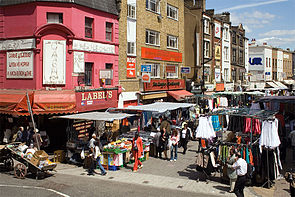
Whitechapel is a district in East London and the future administrative centre of the London Borough of Tower Hamlets. It is a part of the East End of London, 3.4 miles (5.5 km) east of Charing Cross. It was part of the ancient parish of Stepney, Middlesex. It was split off as a separate parish in the 14th century. It became part of the County of London in 1889 and Greater London in 1965. Because the area is close to the London Docklands and east of the City of London, it has been a popular place for immigrants and the working class.

Commercial Street is an arterial road in Tower Hamlets, east London that runs north to south from Shoreditch High Street to Whitechapel High Street through the East End district of Spitalfields. The road is a section of the A1202 London Inner Ring Road and as such forms part of the boundary of the London congestion charge zone.

Aldgate was a gate in the former defensive wall around the City of London. It gives its name to Aldgate High Street, the first stretch of the A11 road, which included the site of the former gate.
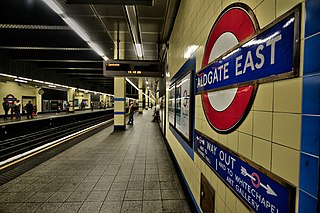
Aldgate East is a London Underground station on Whitechapel High Street in Whitechapel, in London, England. It takes its name from the City of London ward of Aldgate, the station lying to the east of the ward. It is on the Hammersmith & City line between Liverpool Street and Whitechapel, and on the District line between Tower Hill and Whitechapel, in Travelcard Zone 1.

Spitalfields is a district in the East End of London and within the London Borough of Tower Hamlets. The area is formed around Commercial Street and includes the locale around Brick Lane, Christ Church, Toynbee Hall and Commercial Tavern. It has several markets, including Spitalfields Market, the historic Old Spitalfields Market, Brick Lane Market and Petticoat Lane Market. It was part of the ancient parish of Stepney in the county of Middlesex and was split off as a separate parish in 1729. Just outside the City of London, the parish became part of the Metropolitan Board of Works area in 1855 as part of the Whitechapel District. It formed part of the County of London from 1889 and was part of the Metropolitan Borough of Stepney from 1900. It was abolished as a civil parish in 1921.

The Metropolitan Borough of Stepney was a Metropolitan borough in the County of London created in 1900. In 1965 it became part of the London Borough of Tower Hamlets.

Brick Lane is a street in the East End of London, in the borough of Tower Hamlets. It runs from Swanfield Street in Bethnal Green in the north, crosses the Bethnal Green Road before reaching the busiest, most commercially active part which runs through Spitalfields, or along its eastern edge. Brick Lane’s southern end is connected to Whitechapel High Street by a short extension called Osborn Street.
Chuts is the name applied to Jews who immigrated to London from the Netherlands during the latter part of the 19th century. They typically came from Amsterdam and practised trades they had already learned there, most notably cigar, cap and slipper making.
A tenterground, tenter ground or teneter-field was an area used for drying newly manufactured cloth after fulling. The wet cloth was hooked onto frames called "tenters" and stretched taut using "tenter hooks", so that the cloth would dry flat and square.
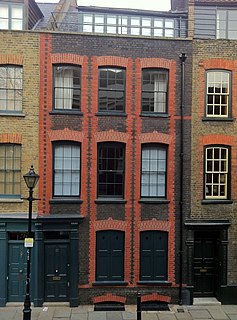
Fournier Street, formerly Church Street, is a street of 18th-century houses in Spitalfields in the East End of London. It is in the London Borough of Tower Hamlets and runs between Commercial Street and Brick Lane. The street is named after a man of Huguenot extraction, George Fournier.
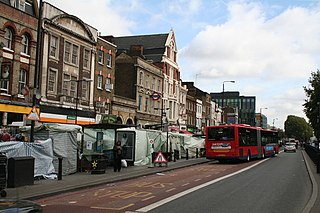
Whitechapel Road is a major arterial road in Whitechapel, Tower Hamlets, in the East End of London. It is named after a small chapel of ease dedicated to St Mary and connects Whitechapel High Street to the west with Mile End Road to the east. The road is part of the historic Roman road from London to Colchester, now the A11.

Whitechapel High Street is a street in the Borough of Tower Hamlets in the East End of London. It is about 0.2 miles long, making it “one of the shortest high streets in London”. It links Aldgate High Street to the south-west with Whitechapel Road to the north-east, and includes junctions with Commercial Street to the north and Commercial Road to the east.

East Smithfield is a small locality in the London Borough of Tower Hamlets, east London, and also a short street, a part of the A1203 road. Once broader in scope, the name came to apply to the part of the ancient parish of St Botolph without Aldgate that was outside of the City of London.
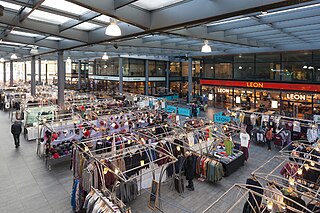
Spitalfields Market is a traders' market as well as a food and art market located in Spitalfields, Central London. Traders began operating around 1666, after the Great Fire of London, where the market stands today. The Spitalfields regeneration programme that ended in 2005, resulted in two new public spaces – Bishops Square and Crispin Place, which restored several historic streets and resulted in more independent retailers and restaurants. Spitalfields Market is situated in the London Borough of Tower Hamlets. It is surrounded by Lamb Street, Old Spitalfields market, Brushfield Street and Bishops Square.

The East End of London, often referred to within the London area simply as the East End, is the historic core of wider East London, east of the Roman and medieval walls of the City of London and north of the River Thames. It does not have universally accepted boundaries to the north and east, though the River Lea is sometimes seen as the eastern boundary. Parts of it may be regarded as lying within Central London. The term "East of Aldgate Pump" is sometimes used as a synonym for the area.

Brick Lane Jamme Masjid, formerly known as the London Jamme Masjid, is a Muslim place of worship in Central London and is in the East End of London. The building at 59 Brick Lane, on the corner of Fournier Street, has been home to a succession of Christian, Jewish, and Muslim communities since its construction in the mid-eighteenth century, reflecting the waves of immigration in the neighbourhood of Spitalfields. The former Great Synagogue is a Grade II* listed building; the adjacent former school buildings is listed Grade II.

Columbia Road Flower Market is a street market in Bethnal Green in London, England. Columbia Road is a road of Victorian shops situated off Hackney Road in the London Borough of Tower Hamlets. The market is open on Sundays only.
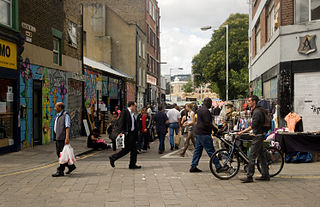
Brick Lane Market is the collective name for a number of London markets centred on Brick Lane, in Tower Hamlets in east London. The original market was located at the northern end of Brick Lane and in the heart of east London's Bangladeshi community but now commonly refers to the various markets that are housed along the famous London street. The various markets that stretch the length of Brick Lane operate both weekdays but most historically weekends: Saturday from 11 a.m. to 6 p.m. and Sunday from 10 a.m. to 6 p.m.
Brick Lane is a 2006 British documentary directed and produced by Minoo Bhatia. The documentary is about the personal stories and journeys of people who have made the street Brick Lane their home, how these different groups have shaped the town and the changing cultural markers that define the area. It was broadcast by BBC Two on 25 March 2006.
